Ofter things
| coat of arms | Germany map | |
|---|---|---|

|
Coordinates: 48 ° 25 ' N , 9 ° 2' E |
|
| Basic data | ||
| State : | Baden-Württemberg | |
| Administrative region : | Tübingen | |
| County : | Tübingen | |
| Height : | 422 m above sea level NHN | |
| Area : | 15.15 km 2 | |
| Residents: | 5088 (December 31, 2018) | |
| Population density : | 336 inhabitants per km 2 | |
| Postal code : | 72131 | |
| Area code : | 07473 | |
| License plate : | TÜ | |
| Community key : | 08 4 16 031 | |
| LOCODE : | DE ODG | |
| Address of the municipal administration: |
Rathausgasse 2 72131 Ofterdingen |
|
| Website : | ||
| Mayor : | Joseph Reichert | |
| Location of the community of Ofterdingen in the Tübingen district | ||
Ofterdingen is a municipality in the district of Tübingen , about 13 kilometers south of Tübingen on the federal highway 27 . It belongs to the Neckar-Alb region and the peripheral zone of the European metropolitan region of Stuttgart .
geography
Geographical location
Ofterdingen is located in the Steinlach valley , a right tributary of the Neckar , and spatially already belongs to the central foothills of the Alb . The western part of Ofterdingen is partly on the Rammert , up to 590 m above sea level. NHN wooded ridge of the Keuperbergland . The municipal area extends at an altitude of 401 to 551 m. ü. NHN (Rathaus Ofterdingen 422 meters above sea level).
Neighboring communities
| Dusslingen | Nehren | |
| Rottenburg am Neckar ( Dettingen district ) |

|
|
| Bodelshausen | Mössingen |
(all municipalities are in the Tübingen district )
Community structure
The village of Ofterdingen and the Jungviehweide homestead, built in 1938, belong to the community.
In the municipality of Ofterdingens are the abandoned , no longer existing villages Benishausen, Meisenhart and Stetten.
geology
Ofterdingen is located in the southwest German layered landscape . The geological subsoil within the localization is characterized by the sequence of rocks from the Black Jura (Lias). The hard limestone layers of the Lias α (Arietenkalk), which form the layer surface west of the town up to Rammert, are characteristic. They are also the reason for the deflection of the flow direction of the Steinlach to the northeast and for the Steinlach waterfall northeast of Ofterdingen. Within the village, the Steinlach flows on the strata of Lias α3 and has exposed the stored fossils, mainly stone cores of ammonites and oysters. This is how the ammonite pavement, famous for the place, was created.
Natural equipment
The extensive orchards on the southern edge of the Rammert and the Kührain and on the Ofterdinger Berg are the habitat of some rare bird species. Small wet meadow areas and reed areas below the Kührain are valuable . The Steinlach streambed is built up throughout the Ofterdingen area and not close to nature. The only natural stream with an alluvial forest gallery made of ash, willow and black alder is the Tannbach on the southern edge of the settlement area, a left tributary of the Steinlach, which previously took in the Buchbach or Ernbach at the municipal boundary to Mössingen.
history
overview
The first documentary mention of the community was around 1115. Later owners were the Counts of Zollern . They sold these to Friedrich Herter von Dußlingen in 1346 .
A connection to the medieval fictional character Heinrich von Ofterdingen von Novalis is unlikely and cannot be proven.
From 1417 to 1802 Ofterdingen belonged to the Bebenhausen monastery . With the introduction of the Reformation in 1534 it passed to the Duchy of Württemberg .
When the new administrative structure was implemented in the Kingdom of Württemberg , which was founded in 1806 , Ofterdingen was assigned to the Rottenburg Oberamt in 1807 . Due to the district reform during the Nazi era in Württemberg , the place became part of the Tübingen district in 1938. In 1945 Ofterdingen became part of the French zone of occupation and thus came to the newly founded state of Württemberg-Hohenzollern , which was incorporated into the state of Baden-Württemberg in 1952.
Population development
|
|
|
religion
The Protestant parish has around 2,450 Protestant Christians. The community was first mentioned in 1266. Since 1356 it has been referred to as St. Moritz (Mauritius). The leadership of the church was held by the Zollern . In 1345 the community went to the Herter family as a fief and from 1417 to 1483 to the Bebenhausen monastery, into which the church was incorporated in 1492. This church on the Ofterdinger Berg was demolished in 1565/67. There was a chapel in the village at the beginning of the 15th century. In 1484 an early measurement pillar was established there and in 1507 the parish rights were probably established. The Reformation was introduced in 1534. The current church is a late Gothic building from 1522. The tower is older and possibly the rest of a former castle.
The New Apostolic Church is also based in Ofterdingen with a congregation. The community has around 150 members.
politics
Municipal council
The municipal council in Ofterdingen has 14 members. The municipal council consists of the elected voluntary councilors and the mayor as chairman. The mayor is entitled to vote in the municipal council. The local elections on May 29, 2019 led to the following preliminary final result. The turnout was 60.2%.
| Political party | be right | Seats |
| Free electoral association | 36.3% | 5 |
| SPD | 35.8% | 5 |
| CDU | 26.6% | 4th |
| BüF | 1.2% | 0 |
mayor
The municipality had five mayors after the Second World War :
| Beginning of the term of office | Term expires | mayor |
|---|---|---|
| July 1927 | September 1946 | Willi Schmid |
| September 1946 | 1949 | Georg Futter |
| 1949 | 3rd January 1967 | Wilhelm Spanagel |
| 4th January 1967 | 1995 | Heinz Aicheler |
| 1995 | today | Joseph Reichert |
On November 7, 2010, Mayor Joseph Reichert was re-elected for a third term. In the election on November 11, 2018, the citizens confirmed Reichert for a fourth term. This starts in January 2019.
coat of arms
Blazon : "In blue, a pile of golden flail, covered with a golden, double-tied sheaf of twelve ears."
The coat of arms of Ofterdingen with a golden sheaf of ears and a golden flail on a blue field symbolizes the agricultural history of the municipality.
Administrative community
The community is in an agreed administrative community with Mössingen and Bodelshausen.
Culture and sights
Museums
- Museum barn in Sattlergasse
Buildings
- Town hall, originally built in 1523
- Evangelical Mauritius Church, construction started in 1522, completed in 1534
- Ofterdingen local library, restored half-timbered building
- Tithe barn in the courtyard, parts from 1568
- Statue of Heinrich von Ofterdingen on the church square
- Former tavern "Goldener Ochsen" (until recently mostly confused with the "White Ox"), half-timbered building from 1759/60
Natural monuments and nature reserves
- The ammonite pavement, a 100 m × 4 m slab of stone made of ariet limestone in the bed of the Steinlach stream , is protected as a geological natural monument and is particularly worth seeing when the water is low.
- Another geological natural monument has been the Steinlach waterfall since 2010 and its surroundings between Ofterdingen and the powder mill.
- The Katzenbach-Dünnbachtal nature reserve is located in the Ofterdinger district.
Sports
The gymnastics and sports club 1904 Ofterdingen e. V. offers various sporting activities. These include football , gymnastics , table tennis , fistball , volleyball , tennis , yoga , dancing and the Run & Walk department . The club sports facilities with the Steinlach stadium, league sports field, training field and gym are located on the Steinlach in the south of Ofterdingen. In the 1980s, the TSV Ofterdingen soccer team played partly in the Oberliga Baden-Württemberg and in the Verbandsliga Württemberg and qualified twice for the DfB Cup (first round matches against Hamburger SV and VfL Bochum were lost at home). Meanwhile, the Ofterdinger play in the District League Alb. The tennis courts of TSV Ofterdingen and the shooting range with shooting range of the Schützenverein Ofterdingen e. V. (founded 1927). The playground of the Pit-Pat Power Club Ofterdingen e. V.
Regular events
- Ofterdinger Flegga-Treff (village festival) every two years.
- Christmas market on the Saturday before the first Advent
societies
The fruit and horticultural association has had its own teaching garden at the club's hut since May 2000 with old fruit varieties from the region. It serves courses, advanced training and environmental education purposes.
Economy and Infrastructure
Agriculture and Forestry
Ofterdingen was formerly a rural area. Additional and part-time businesses are still available today, but no longer characterize the townscape. A full-time business has been relocated to the northern outskirts. A horse farm is located southwest of the village in Gewann Kuhwasen . The stray fruit growing is still playing an important role in Ofterdingen. It is mainly used to produce apple cider. Large orchards are located north of Ofterdingen in the apron of the Rammert and on the Kührain. On the Ofterdinger district there are larger forests in the closed forest area of the Rammert and on the Kührain in the west of the village. They are used intensively for forestry purposes. Large areas are small parceled private forests. Hurricane Lothar caused large-scale storm throws in Rammert and on the Kührain at Christmas 1999. Over several years, the areas were laboriously cleared of storm wood (mainly thrown coniferous wood) and mostly reforested with deciduous trees. Until the end of the 19th century, wine was grown on the southern slope of the Kührain. In the 1980s, wine lovers revived viticulture there on a small scale .
Trade and commerce
Several medium- sized and numerous small businesses are located in the town and in the industrial areas . The wood processing industry traditionally plays an important role. Several handle factories , sawmills and carpenters produce in the village . In addition, a worldwide exporting company for plastic and stainless steel kegs is based in Ofterdingen. Several petrol stations and automobile workshops and dealers have settled on Bundesstraße 27 . The first petrol pump was built next to the Gasthaus Krone at the end of the 1920s and was one of the first on the Chaussée between Stuttgart and Lake Constance, which was then still known as Schweizerstraße . A new commercial area has been developing since the 1980s in the northeastern connection to the place between Steinlach and B 27.
traffic
The federal road 27 runs through the municipality and connects it in the north with Stuttgart and in the south with Balingen and Rottweil . There is a connection to the federal motorway 81 via the Rottenburg am Neckar junction 25 km away in the south to Singen and in the north to Stuttgart.
The Public transport is by the Verkehrsverbund Neckar-Alb-Donau guaranteed (naldo). The community is located in honeycomb 113.
Public facilities
The Mauritiusblick retirement home was built between 2001 and 2003 . The management is jointly with the community of Ofterdingen and the physically handicapped support (KBF) Neckar-Alb in a society under civil law .
education
The Burghof School, a primary and secondary school with a technical secondary school , is responsible for the basic education of children in the community. Secondary schools such as Realschule and Gymnasium as well as a special school are located in Mössingen.
Since the 1990s, children in Ivory Coast have been learning something about the small community in the Tübingen district. Had a large part in it
It is thanks to Jörg Hartenburg, a specialist advisor for German teachers from Ofterdingen, that children in Ivory Coast have learned something about the community since the 1990s. In a German textbook, one chapter is called "a village in southern Germany" .
Supply and disposal
Power supply
The power grid in the community is operated by EnBW Regional AG.
Gas supply
The natural gas network is operated by FairEnergie GmbH, a subsidiary of Stadtwerke Reutlingen GmbH and EnBW Kommunale Beteiligungen GmbH.
Water supply
The water supply in the community is provided by the Steinlach water supply based in Mössingen .
Sanitation
The wastewater disposal is carried out by the wastewater association Steinlach-Wiesaz, based in Dußlingen , which operates an association sewage treatment plant .
Waste disposal
The waste disposal is carried out by the waste management company of the Tübingen district.
Personalities
Honorary citizen
- Wilhelm Spanagel, former mayor from 1949 to 1967
Sons and daughters of the church
- Anton Niclas (1593–1636), gold worker in Tübingen, 1635–1636 mayor of Tübingen
- Georg Luz (1818–1884), teacher and writer
- Liane von Droste (* 1959), journalist and book author
Personalities who have worked on site
- Manfred Korfmann (1942–2005), archaeologist, died in Ofterdingen
- Heiner Kondschak (* 1955), musician, actor, director and author, lives in Ofterdingen
literature
- Albrecht Esche (Ed.): 450 Years Mauritius Church in Ofterdingen 1534–1984 , Ev. Parish, Ofterdingen 1984.
- Albrecht Esche / Karlheinz Lindner: My often things. The Hofhannes tells and shows old pictures , Ev. Parish, Ofterdingen 1993.
- Albrecht Esche: Our old Ofterdingen. Forays into local history , self-published, Mössingen-Öschingen 1995.
- Gerhard Kittelberger: 850 years of Ofterdingen in Steinlachtal: Festival book for the first mention of the village around 1150 . Tübingen 2000, ISBN 3-933916-00-3
- Gerhard Kittelberger: Ofterdingen. Contributions to local history , Geiger-Verlag, Horb am Neckar 2010, ISBN 978-3-86595-411-4 .
Web links
Individual evidence
- ↑ State Statistical Office Baden-Württemberg - Population by nationality and gender on December 31, 2018 (CSV file) ( help on this ).
- ^ Kohlhammer: The state of Baden-Württemberg. Official description by district and municipality . Volume VII: Tübingen administrative region. Stuttgart 1978, ISBN 3-17-004807-4 , pp. 135 f .
- ^ Ludwig Karl Schmidt: History of the Counts of Zollern-Hohenberg and their county . A contribution to the history of the Swabian and German Empire. Ed .: Gbr. Schritlin. Stuttgart 1862, p. II f . ( online [accessed March 7, 2013]).
- ^ Community of Ofterdingen | Ofterdingen is growing - welcoming the 5000th residents. Retrieved September 25, 2017 .
- ^ Community of Ofterdingen | Ofterdingen is growing - welcoming the 5000th residents. Retrieved September 25, 2017 .
- ^ Gerhard Kittelberger: 850 years of Ofterdingen in the Steinlachtal . Festival book for the first mention of the village around 1150. Ed .: Gerhard Kittelberger. Ofterdingen 2000, p. 366-368 .
- ↑ Reichert, Engesser and Knauss are elected. Ofterdingen, Dettenhausen, Kirchentellinsfurt. Schwäbisches Tagblatt, November 7, 2010, accessed on March 7, 2013 .
- ↑ Joseph Reichert was re-elected with 74.3 percent · Voter turnout: 30 percent. Mayoral election: approval with a damper. Schwäbisches Tagblatt, November 11, 2018, accessed on November 12, 2018 .
- ^ Heinrich von Ofterdingen. Retrieved December 9, 2013 .
- ↑ tagblatt.de
- ↑ Sabine Kraume-Propst: Great goodness, Goethe! What will happen to the “White Ox” in Ofterdingen? In: Preservation of monuments in Baden-Württemberg , 38th year 2009, issue 1, p. 30 f. ( PDF ( Memento of the original from January 8, 2014 in the Internet Archive ) Info: The archive link has been inserted automatically and has not yet been checked. Please check the original and archive link according to the instructions and then remove this note. )
- ↑ Jürgen Felbinger: The parlors of the former inn "White Ox" in Ofterdingen. Inventory and preliminary restoration examination. In: Denkmalpflege in Baden-Württemberg , Volume 38, 2009, Issue 1, pp. 32–36 ( PDF ( Memento of the original from January 8, 2014 in the Internet Archive ) Info: The archive link was inserted automatically and has not yet been checked. Please check the original and archive link according to the instructions and then remove this note. )
- ↑ Ofterdingen - Steinlachstadion. soke2.de, March 17, 2007, accessed March 7, 2013 .
- ^ Ofterdingen shooting club V. sv-ofterdingen.de, accessed on May 14, 2015 .
- ↑ Winner: the “Ofterdinger Fleggatreff”. Village festival - memorable and not too long: Association representatives and mayors chose a name for the event. Two dozen suggestions had been received. Reutlinger Generalanzeiger, January 26, 2011, accessed on March 7, 2013 .
- ↑ Mauritiusblick retirement home. Ofterdingen.de, accessed on March 7, 2013 .
- ↑ Delegation from Bouaké in Ofterdingen Visit from Africa in the school book community on swr.de from November 12, 2019
- ↑ Why Ofterdingen is famous in West Africa Video of the Baden-Württemberg state show on SWR TV BW on November 13, 2019
- ↑ Visit of a delegation from the city of Bouaké on the Ivory Coast. Information from the city of Ofterdingen
- ↑ BDEW (Ed.): Map of the electricity network operator 2012. Frankfurt 2012.
- ↑ BDEW (Ed.): Map of the gas network operators 2012. Frankfurt 2012.
- ^ Gerhard Kittelberger: 850 years of Ofterdingen in the Steinlachtal . Festival book for the first mention of the village around 1150. Ed .: Gerhard Kittelberger. Ofterdingen 2000, p. 367 .










